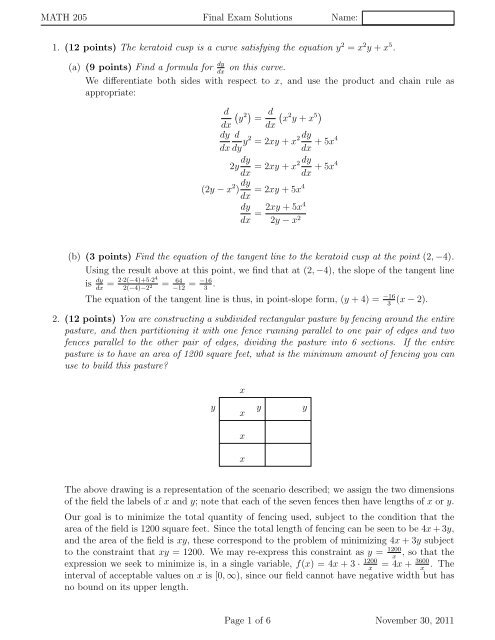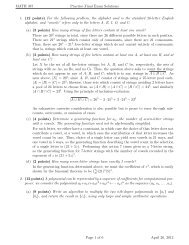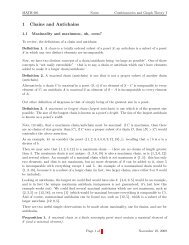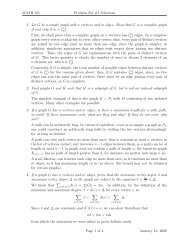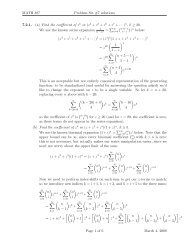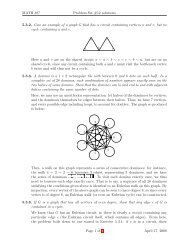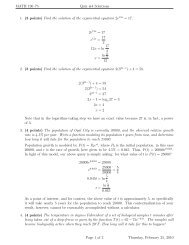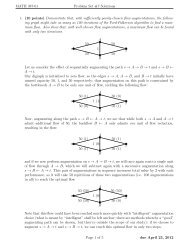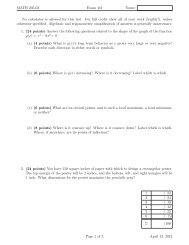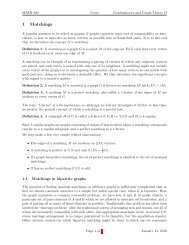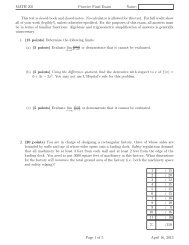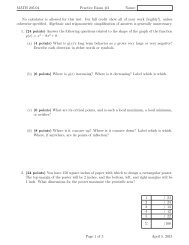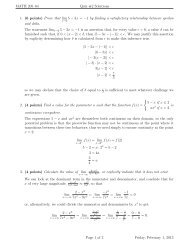MATH 205 Final Exam Solutions Name: 1. (12 points) The keratoid ...
MATH 205 Final Exam Solutions Name: 1. (12 points) The keratoid ...
MATH 205 Final Exam Solutions Name: 1. (12 points) The keratoid ...
Create successful ePaper yourself
Turn your PDF publications into a flip-book with our unique Google optimized e-Paper software.
<strong>MATH</strong> <strong>205</strong> <strong>Final</strong> <strong>Exam</strong> <strong>Solutions</strong> <strong>Name</strong>:<br />
<strong>1.</strong> (<strong>12</strong> <strong>points</strong>) <strong>The</strong> <strong>keratoid</strong> cusp is a curve satisfying the equation y 2 = x 2 y + x 5 .<br />
(a) (9 <strong>points</strong>) Find a formula for dy on this curve.<br />
dx<br />
We differentiate both sides with respect to x, and use the product and chain rule as<br />
appropriate:<br />
d ( ) y<br />
2<br />
= d (<br />
x 2 y + x 5)<br />
dx dx<br />
dy d<br />
dx dy y2 = 2xy + x 2 dy<br />
dx + 5x4<br />
2y dy<br />
dy<br />
= 2xy + x2<br />
dx dx + 5x4<br />
(2y − x 2 ) dy = 2xy + 5x4<br />
dx<br />
dy<br />
dx<br />
=<br />
2xy + 5x4<br />
2y − x 2<br />
(b) (3 <strong>points</strong>) Find the equation of the tangent line to the <strong>keratoid</strong> cusp at the point (2, −4).<br />
Using the result above at this point, we find that at (2, −4), the slope of the tangent line<br />
is dy = 2·2(−4)+5·24 = 64 = −16.<br />
dx 2(−4)−2 2 −<strong>12</strong> 3<br />
<strong>The</strong> equation of the tangent line is thus, in point-slope form, (y + 4) = −16 (x − 2).<br />
3<br />
2. (<strong>12</strong> <strong>points</strong>) You are constructing a subdivided rectangular pasture by fencing around the entire<br />
pasture, and then partitioning it with one fence running parallel to one pair of edges and two<br />
fences parallel to the other pair of edges, dividing the pasture into 6 sections. If the entire<br />
pasture is to have an area of <strong>12</strong>00 square feet, what is the minimum amount of fencing you can<br />
use to build this pasture?<br />
x<br />
y y y<br />
x<br />
x<br />
x<br />
<strong>The</strong> above drawing is a representation of the scenario described; we assign the two dimensions<br />
of the field the labels of x and y; note that each of the seven fences then have lengths of x or y.<br />
Our goal is to minimize the total quantity of fencing used, subject to the condition that the<br />
area of the field is <strong>12</strong>00 square feet. Since the total length of fencing can be seen to be 4x + 3y,<br />
and the area of the field is xy, these correspond to the problem of minimizing 4x + 3y subject<br />
to the constraint that xy = <strong>12</strong>00. We may re-express this constraint as y = <strong>12</strong>00 , so that the<br />
x<br />
expression we seek to minimize is, in a single variable, f(x) = 4x + 3 · <strong>12</strong>00 = 4x + 3600.<br />
<strong>The</strong><br />
x x<br />
interval of acceptable values on x is [0, ∞), since our field cannot have negative width but has<br />
no bound on its upper length.<br />
Page 1 of 6 November 30, 2011
<strong>MATH</strong> <strong>205</strong> <strong>Final</strong> <strong>Exam</strong> <strong>Solutions</strong> <strong>Name</strong>:<br />
Since f ′ (x) = 4− 3600 , we see that f ′ (x) will have 3 critical <strong>points</strong>: one when x = 0, where f ′ (x)<br />
x 2<br />
is undefined, and two at the solutions to 4 − 3600 = 0, which occur at x = ± √ 900 = ±30. Our<br />
x 2<br />
options for maximizing choices of x are thus the 3 critical <strong>points</strong> 0, −30, and 30, together with<br />
the interval end<strong>points</strong> 0 and the limiting behavior as x → ∞. −30 is outside the interval and<br />
may be rejected out of hand. Evaluating at the other three <strong>points</strong>, we see that f(x) does not<br />
exist at x = 0, but that lim x→0 + f(x) = +∞; lim x→+∞ f(x) = +∞, and f(30) = 4 · 30 + 3600.<br />
30<br />
This last value need not be completely calculated; it is finite, and thus a better minimum than<br />
the other two prospects. Thus, our area-minimizing choice of x is 30, which has an associated<br />
value of y = <strong>12</strong>00 = 40, so our optimal dimensions are 30 × 40.<br />
30<br />
3. (<strong>12</strong> <strong>points</strong>) G-23 paxilon hydrochlorate is eliminated from the bloodstream at a rate of <strong>12</strong>%<br />
per hour. Miranda has just taken a 40mg intravenous dose.<br />
(a) (4 <strong>points</strong>) Construct a function modeling the quantity of the drug in her body after t<br />
hours.<br />
Since the elimination rate is <strong>12</strong>%, the quantity of the drug is f(t) = 40e −0.<strong>12</strong>t .<br />
(b) (4 <strong>points</strong>) How quickly is the drug being eliminated after 2 hours?<br />
<strong>The</strong> rate of eliminaiton is denoted by f ′ (t); here, f ′ (t) = 40·(−0.<strong>12</strong>)e −0.<strong>12</strong>t , and specifically<br />
f ′ (2) = 40(−0.<strong>12</strong>)e −0.24 , which is approximately −3.77, i.e. an elimination rate of 3.77<br />
mg/hour.<br />
(c) (4 <strong>points</strong>) How many hours does it take for the quantity of the drug to drop below 10mg?<br />
We solve for the value of t such that f(t) = 10:<br />
10 = 40e −0.<strong>12</strong>t<br />
1<br />
4 = e−0.<strong>12</strong>t<br />
ln 1 4 = −0.<strong>12</strong>t<br />
ln 1 4<br />
−0.<strong>12</strong> = t<br />
so there will only be 10mg remaining after ln 1 4<br />
−0.<strong>12</strong><br />
4. (<strong>12</strong> <strong>points</strong>) Let h(x) = (x 2 + 1)e x .<br />
≈ 1<strong>1.</strong>6 hours.<br />
(a) (5 <strong>points</strong>) Where is h(x) increasing? Where is it decreasing?<br />
We calculate h ′ (x) = (x 2 + 1)e x + 2xe x = (x 2 + 2x + 1)e x ; since h ′ (x) = (x + 1) 2 e x , it is<br />
evident that h ′ (x) = 0 at x = −1, but is positive everywhere else, so h(x) is increasing<br />
where h ′ (x) is positive, which is to say when x ≠ −<strong>1.</strong><br />
(b) (7 <strong>points</strong>) Determine h(x)’s concavity and identify <strong>points</strong> of inflection.<br />
We calculate h ′′ (x) = (x 2 + 2x + 1)e x + (2x + 2)e x = (x 2 + 4x + 3)e x ; since h ′′ (x) =<br />
(x + 1)(x + 3)e x , it is evident that h ′ (x) = 0 at x = −1 and x = −3. Now we can<br />
probe in the three regions: when x < −3, when −3 < x < −1, and when x > −1, with<br />
the three following respective calculations: h ′′ (−4) = ((−4) 2 + 4(−4) + 3)e −4 = 3e −4 ,<br />
h ′′ (−2) = ((−2) 2 + 4(−2) + 3)e −2 = −e −2 , and h ′′ (0) = (0 2 + 4 · 0 + 3)e 0 = 3, so the<br />
diagram of the sign of h ′′ (x) at various values is given by:<br />
Page 2 of 6 November 30, 2011
<strong>MATH</strong> <strong>205</strong> <strong>Final</strong> <strong>Exam</strong> <strong>Solutions</strong> <strong>Name</strong>:<br />
+ + + + + + + 0 − − − − − − − − − − − 0 + + ++<br />
−3<br />
−1<br />
so h(x) is concave up where h ′′ (x) is positive, which is to say when x < −3 or x > −<strong>1.</strong> h(x)<br />
is concave down where h ′′ (x) is negative, which is to say when −3 < x < −<strong>1.</strong> <strong>The</strong> <strong>points</strong><br />
of inflection are places where the concavity changes, which is at x = −3 and x = −<strong>1.</strong><br />
5. (8 <strong>points</strong>) Answer the following questions about the function g(x) = √ 25 − x 2 .<br />
(a) (4 <strong>points</strong>) What is the domain of g(x)?<br />
g(x) is defined as long as the argument of the square root is non-negative, so wherever<br />
25 − x 2 ≥ 0, whihc is when x 2 ≤ 25, which is in the interval [−5, 5].<br />
(b) (4 <strong>points</strong>) Where does the derivative of g(x) exist?<br />
Using the chain rule, g ′ (x) =<br />
−2x<br />
2 √ . <strong>The</strong> argument of the square root must exist, limiting<br />
25−x 2<br />
our options to the domain found in part (a), but in addition it must be nonzero, so we<br />
must additionally exclude values such that 25 − x 2 = 0, which are x = ±5. Thus, our<br />
interval of differentiability is (−5, 5).<br />
6. (<strong>12</strong> <strong>points</strong>) Consider the function g(x) = ex<br />
x+2 .<br />
(a) (5 <strong>points</strong>) Identify the zeroes, vertical asymptotes, and long-term behavior on both sides<br />
of this function. Clearly label which is which.<br />
Since e x > 0 for all x, this function has no zeroes, and the vertical asymptote occurs when<br />
the denominator is zero, at x = −2. In the long term, this function’s dominant terms in<br />
the numerator and denominator are e x and x respectively, so lim x→+∞ g(x) = +∞ and<br />
lim x→−∞ g(x) = 0.<br />
(b) (5 <strong>points</strong>) Identify the critical <strong>points</strong> of this function, and indicate whether each is a local<br />
maximum, local minimum, or neither.<br />
Using the quotient rule,<br />
g ′ (x) = (x + 2) ( d<br />
ex) − e ( x d<br />
(x + 2))<br />
dx dx<br />
(x + 2) 2<br />
= (x + 2)ex − e x<br />
(x + 2) 2<br />
(x + 1)ex<br />
=<br />
(x + 2) 2<br />
While the zero of the denominator might be considered a critical point, it is not a local<br />
extremum, since the function g(x) is in fact discontinuous there. Thus, the only extremum<br />
we need worry about is the zero of (x + 1)e x . This occurs at x = −<strong>1.</strong> Noting that x + 1<br />
is negative if x < −1 and positive if x > −1, this extremum is a local minimum.<br />
(c) (2 <strong>points</strong>) Which if any of the critical <strong>points</strong> identified above are global maxima or global<br />
minima? Show work or explain.<br />
x = −1 is actually a global minimum, since g ′ (−1) is negative, placing it below either of<br />
the long-term behaviors.<br />
Page 3 of 6 November 30, 2011
<strong>MATH</strong> <strong>205</strong> <strong>Final</strong> <strong>Exam</strong> <strong>Solutions</strong> <strong>Name</strong>:<br />
7. (<strong>12</strong> <strong>points</strong>) Evaluate the following integrals:<br />
(a) (4 <strong>points</strong>) ∫ 2<br />
0<br />
sec √ x tan √ x<br />
√ x<br />
dx.<br />
Since we have sec √ x tan √ x in the integrand, it makes sense to use the substitution<br />
u = √ x to simplify this expression to sec u tan u. We are particularly fortunate since then<br />
du<br />
= 1<br />
dx 2 √ and thus 2du = √1<br />
x x<br />
dx, and a division by √ x is in fact present in our integral.<br />
We may now perform the u-substitution:<br />
∫ 2<br />
0<br />
sec √ x tan √ x<br />
√ x<br />
dx =<br />
(b) (4 <strong>points</strong>) ∫ 1<br />
−2 2x2 + 3<br />
x 2 +1 dx.<br />
Using known antiderivatives,<br />
∫ 1<br />
−2<br />
∫ √ 2<br />
0<br />
√<br />
sec u tan u(2du) = 2 sec u] 2<br />
0<br />
= 2 sec √ 2 − 2 sec 0<br />
2x 2 + 3 [ 1 2<br />
x 2 + 1 dx = 3 x3 + 3 arctan x]<br />
= 2 ( )<br />
−16<br />
−2<br />
3 + 3 arctan 1 − 3 + 3 arctan(−2)<br />
(c) (4 <strong>points</strong>) ∫ 1<br />
x ln x dx.<br />
1<br />
Since we have in the integrand, it makes sense to use the substitution u = ln x to<br />
ln x<br />
simplify this expression to 1 du<br />
. We are particularly fortunate since then = 1 and thus<br />
u dx x<br />
du = 1 dx, and a division by x is in fact present in our integral. We may now perform the<br />
x<br />
u-substitution: ∫<br />
∫<br />
1 1<br />
x ln x dx = du = ln u + C = ln(ln x) + C<br />
u<br />
8. (<strong>12</strong> <strong>points</strong>) Determine the following limits.<br />
(a) (4 <strong>points</strong>) Evaluate lim x→0 (e x − 1) csc x or demonstrate that it cannot be evaluated.<br />
This is a 0 × ∞ form which can be rephrased as the 0 indeterminate form lim 0 x→0 ex −1<br />
. sin x<br />
Applying L’Hôpital’s rule:<br />
e x − 1<br />
lim<br />
x→0 sin x = lim e x<br />
x→0 cos x = 1 1 = 1<br />
(b) (4 <strong>points</strong>) Using the difference quotient, find the derivative with respect to x of f(x) =<br />
4x 2 − x + 5. You may not use L’Hôpital’s rule for this problem.<br />
f ′ (x) = lim<br />
h→0<br />
f(x + h) − f(x)<br />
h<br />
(4(x + h) 2 − (x + h) + 5) − (4x 2 − x + 5)<br />
= lim<br />
h→0 h<br />
(4x 2 + 8xh + 4h 2 − x − h + 5) − (4x 2 − x + 5)<br />
= lim<br />
h→0 h<br />
8xh + 4h 2 − h<br />
= lim<br />
h→0 h<br />
= lim 8x + 4h − 1 = 8x − 1<br />
h→0<br />
Page 4 of 6 November 30, 2011
<strong>MATH</strong> <strong>205</strong> <strong>Final</strong> <strong>Exam</strong> <strong>Solutions</strong> <strong>Name</strong>:<br />
1<br />
(c) (4 <strong>points</strong>) Evaluate lim t→∞ or demonstrate that it cannot be evaluated.<br />
t 2 e t<br />
As t gets very large, the denominator of this expression will get very large while the<br />
numerator is a constant 1; as a result, the limit is 0.<br />
9. (<strong>12</strong> <strong>points</strong>) A sentry at Blackgate Prison has turned a spotlight on an escapee who is currently<br />
0.3 miles to the north and 0.4 miles to the east of the prison. She notices that the escapee is<br />
traveling eastwards at four miles per hour.<br />
(a) (6 <strong>points</strong>) How quickly will she need to rotate the spotlight to keep it trained on the<br />
escapee?<br />
Let the angle of the spotlight from true north be called θ, and let the distance the fugitive<br />
is to the east of the prison be called x. Since the fugitive is a constant distance 0.3 to the<br />
north of the prison, and a distance x easy of the prison, drawing a right triangle makes it<br />
clear that tan θ = x . 0.3<br />
We know that x is currently 0.4, and that dx = 4¡ so we may use related-rates techniques<br />
dt<br />
to determine dθ , differentiating each side of the above relationship with respect to t:<br />
dt<br />
d<br />
dt tan θ = d x<br />
dt 0.3<br />
dθ<br />
dt<br />
d<br />
dθ tan θ<br />
dx<br />
= dt<br />
dθ<br />
0.3 dt sec2 θ =<br />
dx<br />
dt<br />
dθ<br />
0.3 dt<br />
=<br />
dx<br />
dt cos2 θ<br />
0.3<br />
and since θ is in a right triangle adjacent to a side of length 0.3 and with hypotenuse 0.5,<br />
we may specifically expand that to<br />
in radians per hour.<br />
dx<br />
dθ<br />
dt = dt cos2 θ<br />
0.3<br />
= 4 ( )<br />
0.3 2<br />
0.5<br />
0.3<br />
= <strong>1.</strong>2<br />
0.25 = 4.8<br />
(b) (6 <strong>points</strong>) How quickly is the escapee’s distance from the prison changing?<br />
d<br />
dt (0.32 + x 2 ) = d dt (s2 )<br />
dx d<br />
dt dx (x2 ) = ds d<br />
dt ds (s2 )<br />
dx ds<br />
(2x) =<br />
dt dt (2s)<br />
x dx<br />
dt<br />
s<br />
= ds<br />
dt<br />
And since x and s have current values of 0.4 and 0.5 respectively, ds<br />
dt = 0.4·4<br />
0.5 = 3.2<br />
10. (<strong>12</strong> <strong>points</strong>) Answer the following questions:<br />
(a) (4 <strong>points</strong>) Find ∫ d e t<br />
dt. dt t<br />
We know that in general ∫ d<br />
f(t)dt = f(t) + C, so in this case, ∫ d<br />
dt dt<br />
e t et<br />
dt = + C.<br />
t t<br />
(b) (4 <strong>points</strong>) Find d<br />
dx arctan x2 −1<br />
x+2 . Page 5 of 6 November 30, 2011
<strong>MATH</strong> <strong>205</strong> <strong>Final</strong> <strong>Exam</strong> <strong>Solutions</strong> <strong>Name</strong>:<br />
Let u = x2 −1; we can use the chain rule and then the quotient rule:<br />
x+2<br />
d<br />
dx arctan x2 − 1<br />
x + 2 = d<br />
dx arctan u<br />
= du d<br />
dx du arctan u<br />
( ) d x 2 − 1 1<br />
=<br />
dx x + 2 1 + u<br />
( 2<br />
)<br />
(x + 2)(2x) − (x 2 − 1)(1) 1<br />
=<br />
(x + 2) 2 1 + ( x 2 −1<br />
x+2<br />
) 2<br />
(c) (4 <strong>points</strong>) Given g(s) = d ds es cot(s 2 ), find g ′ (s).<br />
Using the product rule, g(s) = e s cot(s 2 ) − 2se s csc 2 (s 2 ). <strong>The</strong>n, using the product rule<br />
again, with several applications of the chain rule:<br />
g ′ (s) = e s cot(s 2 ) − 4se s csc 2 (s 2 ) − 2e s csc 2 (s 2 ) + 8s 2 e s csc(s 2 ) csc(s 2 ) cot(s 2 )<br />
Page 6 of 6 November 30, 2011


